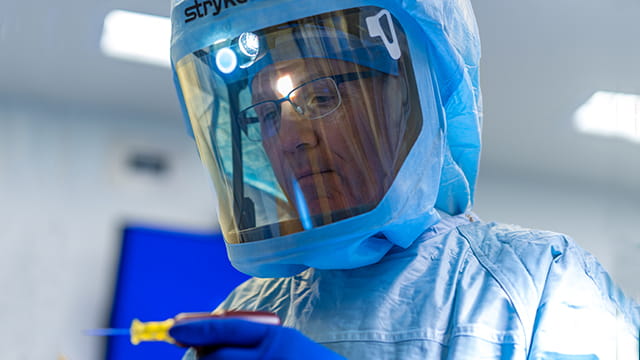Intraosseous Antibiotic Delivery Method Shows Promise in Total Hip Arthroplasty
Dec. 22, 2023 - Eden McCleskeyIn a groundbreaking study that could transform orthopedic surgeons' administration of prophylactic antibiotics for joint replacement surgery, Houston Methodist researchers found that injecting vancomycin directly into the bone marrow before total hip arthroplasty (THA) increased concentration of the drug locally while reducing the amount circulating systemically.
The intraosseous (IO) method offers significant advantages over the traditional intravenous (IV) administration of vancomycin, a process that takes hours to complete and requires significant effort to coordinate.
"The process of infusing vancomycin by IV is cumbersome, and it can pose a risk of side effects to the patient's kidneys and hearing," said Dr. Terry Clyburn, an orthopedic surgeon at Houston Methodist and primary investigator on the study. "By injecting vancomycin directly in the bone, we increase the safety and efficiency of the procedure while still offering patients robust protection against the devastating consequences of a periprosthetic joint infection (PJI)."
The study, published in the Journal of Arthroplasty, received the prestigious Otto Aufranc Award for innovation from the Hip Society.
The Houston Methodist researchers involved in the study, including Dr. Clyburn, Dr. Kwan Park, Dr. Stephen Incavo and Francesca Taraballi, Ph.D., previously developed a similar technique for total knee arthroplasty, finding that IO infusions demonstrated higher antibiotic levels in the local tissues and reduced systemic levels. A statistically significant reduction in infection rate was also found.
"Knee replacement and hip replacement surgeries have similar rates of infection, but we started with knee replacements so we could use a tourniquet," Dr. Clyburn explained. "For hip replacements, we obviously can't apply a tourniquet, so initially there was concern that the IO dose of antibiotics could rapidly enter the bloodstream."
In a randomized, single-blinded control study design, 20 patients were divided into two groups: one receiving IV vancomycin and the other IO vancomycin, injected into the trochanteric bone of the hip. Results from the study showed that IO vancomycin resulted in virtually undetectable systemic levels, thus resolving the concern about not using a tourniquet.
Bone and tissue samples obtained during surgery showed that IO vancomycin resulted in higher local concentration of the drug compared with IV vancomycin. In fact, tissue concentrations of vancomycin were higher in all samples, with statistically significant increases in the acetabular bone reamings and a trend toward significance in intramedullary femoral bone.
As an additional benefit, IO administration resolves a significant problem for OR nurses and staff. Vancomycin by IV requires monitoring of a slow drip precisely one to two hours before surgery. With the intraosseous procedure, the surgeon can administer the drug minutes before the operation begins. Additionally, a higher dose can be administered without risking systemic effects.
"There are risks involved in underdosing vancomycin just like there are risks to overdosing it," said Dr. Clyburn. "Increasing the amount of protection located at the site of the surgery, while decreasing serum levels, may improve the drug's prophylactic performance against methicillin-resistant Staphylococcus aureus (MRSA) and other infections."
With infection rates ranging from 0.4% to 1.4% in THA, the study's findings could have significant implications for improving outcomes and lowering the risk of complications associated with PJI.
"IO administration of vancomycin is a novel and effective way to reduce the risk of complications associated with PJI while addressing challenges related to antibiotic timing, dosing adequacy and systemic side effects," Dr. Clyburn said.
Larger scale follow-up studies are currently underway to help researchers determine if this innovative antibiotic delivery method translates into clinical reductions in infection rates and improved surgical outcomes in THA.


